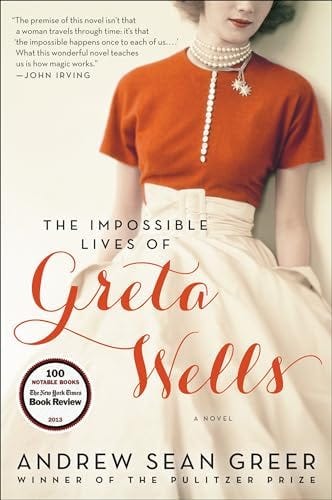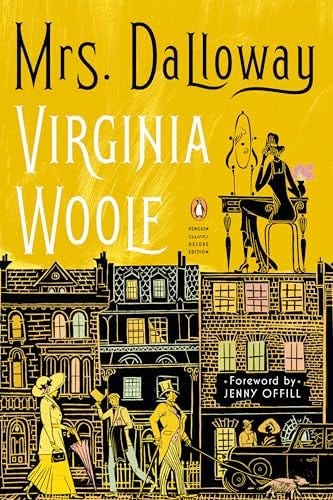Time Travel
“This is what time travel is. It’s looking at a person, and seeing them in the present and the past, concurrently." ― Gabrielle Zevin, Tomorrow, and Tomorrow, and Tomorrow
With the end of the school year ironically comes one of the busiest times of my year — juggling graduation, young children and their first weeks of break, family vacations, and one of my favorite educational conferences, of which I have attended and presented at for 3 years now. As I contemplate all the ideas from this conference, as well as the purpose of the conference — girls’ education — I’m thinking about time travel, and the different ways girls and women have appeared, or disappeared, over time. I’m writing from Philadelphia which is in the middle of a heat wave, and I’m reminded of a New York City heatwave over a decade ago, when I was leading a groups of students around the city. I had brought The Impossible Lives of Greta Wells by Andrew Sean Greer with me because I love to read a book set in the city I’m visiting (for this trip I brought The Secret Lives of Church Ladies which I know is not Philadelphia-focused but it’s Pennsylvania!). That book resonated and I still think of it often.
Time travel is one of my favorite genres, but as I start to write my own time travel novel, I find myself considering the many different types of time travel, and Greta Wells’ experience is a powerful one—the locus of which is setting. As a result of electroshock therapy, she jumps from time to time, but her loved ones and the location remain constant, as do the unsettling circumstances causing her depression—they just look different in each time period. Each life lived, each time period, is, of course, a metaphor. And since you know I can’t just think of one book at a time, my mind traveled to The Hours by Michael Cunningham, and there were such clear connections I was shocked that I hadn’t placed the two together before, though they’re both on my favorite book lists.
I have taught The Hours several times because of the clear connection to Mrs. Dalloway by Virginia Woolf, which I also teach. Once Less by Andrew Sean Greer won the Pulitzer (2018) I suppose I took my own taste more seriously, but up until that point I had only thought of it as a good read, which in my mind can be different from a good book.
The Impossible Lives of Greta Wells by Andrew Sean Greer
Greta Wells, grieving the death of her twin brother and the loss of her partner, undergoes electroconvulsive therapy (electroshock) and finds herself living alternate versions of her life in 1918, 1941, and 1985. In each timeline, she inhabits different versions of womanhood, queerness, and emotional repression, while the constants of place and relationships force her to confront how grief, identity, and love change across eras. The novel explores feminist and queer temporality, showing how time is less about how it passes and more about who we are allowed to be.
The Hours by Michael Cunningham
Three women—Virginia Woolf in 1923, Laura Brown in 1949, and Clarissa Vaughn in 1999—live parallel lives bound by Mrs. Dalloway, either writing it, reading it, or reliving it/experiencing it (Vaughn’s role is difficult to convey without spoiling some of the deliciousness!). Each woman navigates internalized expectations of domesticity, queerness, and existential longing, asking what it means to live authentically while tethered to time, gender, and narrative. The novel becomes a meditation on cyclical time, emotional inheritance, and the way time weighs upon a person. It’s helpful to have read Mrs. Dalloway but not entirely necessary.
Mrs. Dalloway by Virginia Woolf
Over the course of a single June day in post-WWI London, Clarissa Dalloway prepares for a party, reflecting on her youth, her unspoken love for Sally, and the paths her life didn’t take. The novel interweaves her consciousness with that of Septimus Warren Smith, a shell-shocked veteran whose suicide becomes an invisible hinge between lives. Woolf collapses past and present through stream of consciousness, crafting a narrative where time is nonlinear, memory is a form of travel, and identity is always flickering between selves imagined and selves lived.
Grief as a Time Machine
Greta doesn’t move through time because of curiosity or science; she’s propelled by grief. As she reflects in The Impossible Lives of Greta Wells, “Grief will go--it always does-- but not before it forces us to do these absurd things, and hurt ourselves, and bring on suffering, because grief, that parasite, above all else does not want to die, and only in these terrible moments it creates can it feel itself thrashing back to life.” Her brother is dead. Her partner has left. She is, in a sense, suspended.
In The Hours, Clarissa Vaughn spends a single day preparing for a party while grieving the impending death of her dear friend Richard, a brilliant, tormented poet living with AIDS. The entire novel takes place in a compressed timeframe, but memory intrudes constantly, collapsing the past into the present.
In Mrs. Dalloway, Clarissa reflects on her youth, her unspoken love for Sally, and the recent suicide of Septimus Warren Smith, a man she never knew. The loss becomes metaphysical—death as a presence that shadows the ordinary day.
Grief disrupts chrononormativity. The "proper" timeline collapses when you lose someone, and both Greta’s treatment and Clarissa’s wandering interiority literalize that collapse. In these novels, time travel doesn’t erase pain—it refracts it. Each version of life offers a new lens, but not a cure.
Queer Time
In The Impossible Lives of Greta Wells, queerness is present, tender, and dangerous—sometimes closeted, sometimes open, always constrained by the decade. Her twin brother Felix is dead of AIDS in one timeline, alive in another. The novel asks: how does queerness can survive history’s expectations?
In The Hours, queerness lives beneath the surface: in Laura Brown’s quiet longing, in Clarissa’s past with Richard, in the sense of a life unchosen and constantly echoing. Queer love is remembered, mourned, and refracted through domestic spaces and the impossible roles expected of women.
In Mrs. Dalloway, Clarissa remembers her kiss with Sally as the most thrilling moment of her life—more vivid than her marriage, more real than her present. Yet it exists only in memory, shaped by social constraint and never spoken aloud. Queer longing in all three novels lingers in the margins of the acceptable, charged with desire but muted by time.
Sara Jaffe, in “JSTOR Daily” discusses queer time:
Queer scholar Jack Halberstam’s 2005 book In a Queer Time and Place argues that “queer uses of time and space develop… in opposition to the institutions of family, heterosexuality, and reproduction.” Queerness itself is “an outcome of strange temporalities, imaginative life schedules, and eccentric economic practices.” It is inflected by time-warping experiences as diverse as coming out, gender transitions, and generation-defining tragedies such as the AIDS epidemic. That is, queerness is constituted by its difference from conventional imperatives of time.
Poet Mark Doty writes: “All my life I’ve lived with a future which constantly diminishes but never vanishes” (Doty 1996, 4).
Kristeva’s “Women’s Time”
Time in these novels isn’t linear or historical—it’s monumental and cyclical. Julia Kristeva writes in "Women’s Time" that female subjectivity often resists linear, historical time and instead operates in cyclical or monumental temporality—linked more to repetition and gestation than to progress or conquest.
As for time, female subjectivity would seem to provide a specific measure that essentially retains repetition and eternity from among the multiple modalities of time known through the history of civilizations. On the one hand, there are cycles, gestation, the eternal recurrence of a biological rhythm which conforms to that of nature and imposes a temporality whose stereotyping may shock, but whose regularity and unison with what is experienced as extra subjective time, cosmic time, occasion vertiginous visions and unnamable jouissance.
These novels echo her claim that women’s time bends around memory, repetition, and emotional rhythm, rather than historical chronology. Women are tethered to domestic cycles (cooking, childrearing, caretaking) but they also access deep memory, where grief, desire, and repression remain ever-present. In Greta and the Clarissa’s, as well as Laura Brown, we see a sense of being both out of time and held by it.
As I think about these books, I am struck by how my love of time travel is so much more layered than I’d originally thought, and of course thrilled that so many other theorists have done such deep work on the subject. I love Outlander and the more obvious forms of time travel, but I’m pretty taken by this expansive definition.





I love time travel and sliding doors fiction!
I really enjoyed reading your thoughts on time travel through literary threads. It’s given me new insights on the use of time in narratives. Thanks.